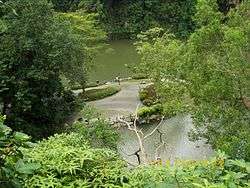National Parks Board
The National Parks Board (NParks) is a statutory board of the Government of Singapore.
 | |
| Agency overview | |
|---|---|
| Formed | 1 July 1996 |
| Preceding agencies |
|
| Jurisdiction | Government of Singapore |
| Headquarters | Singapore Botanic Gardens, 1 Cluny Road, Singapore 259569 |
| Agency executives | |
| Parent agency | Ministry of National Development |
| Website | http://www.nparks.gov.sg |
NParks is responsible for providing and enhancing the greenery of Singapore, which the government calls a "City in a Garden".[2] Beyond building green infrastructure, NParks is actively engaging the community to enhance the quality of their living environment. NParks manages over 300 parks and 4 nature reserves. There is a hierarchy and diversity of parks, ranging from large regional parks to neighbourhood parks and playgrounds, where a spectrum of natural ecosystems co-exists with horticultural gardens. Adding to this is the extensive streetscape, or roadside greenery, that forms the backbone of the City in a Garden. An island-wide Park Connector Network is also being developed to link major parks, nature areas and residential estates.
As the lead agency on biodiversity conservation, NParks has developed an urban biodiversity conservation model, which aims to conserve representative eco-systems in land-scarce Singapore. NParks also monitors and coordinates measures to enhance the presence of biodiversity in Singapore’s urban landscape. NParks is working closely with partners in the landscape and horticulture industry to increase productivity, and provide training for all levels of the workforce. Enhancing competencies of the industry will support Singapore’s vision of being a City in a Garden.
History
The history of NParks is closely interlinked with the history of tree-planting in Singapore.[3] In the 1960s, when the Singapore government embarked on nation building, Mr Lee Kuan Yew, then Prime Minister, was intent on transforming Singapore into a Garden City. Beginning with the first Tree Planting Campaign in 1963, the government embarked on an initiative to green up the island. This initiative was carried through into the 1970s and 1980s under the Parks and Recreation Department (PRD). On 1 July 1996, PRD was renamed the National Parks Board. Since then, NParks’ mission has gradually evolved from realising a vision for a Garden City to creating a City in a Garden.[4] Since 1 April 2019, all non-food plant and animal-related functions originally under the Agri-Food and Veterinary Authority of Singapore were transferred to NParks under Animal and Veterinary Service (AVS) as part of a reorganisation.[5][6]
The City in a Garden framework
To introduce the City in a Garden (CIAG) vision and framework, NParks launched a public engagement exercise in August 2011 to encourage all Singaporeans to contribute their views. The agency identified six key areas, which form the framework for creating a City in a Garden, and Singaporeans were invited to build on these ideas or contribute new ones to co-create a greener, more endearing home. The six key areas include “establish world-class gardens”, “rejuvenate urban parks and enliven our streetscape”, “optimise urban spaces and infrastructure for greenery and recreation”, “enrich biodiversity in our urban environment”, “enhance competencies of our landscape and horticulture industry” and “engage and inspire communities to co-create a greener Singapore”.[2]
References
- "New NParks CEO appointed". Channel NewsAsia. Archived from the original on 26 February 2014. Retrieved 22 February 2014.
- "City in a Garden".
- Trees of Singapore
- Tale of a Magical Seed
- Wong, Derek (26 July 2018). "Increased expertise, more holistic overview of flora and fauna for NParks". The Straits Times. Retrieved 26 January 2020.
- Matthew, Mohan. "New stat board to oversee food safety and security; AVA to be disbanded". Channel NewsAsia. Retrieved 26 July 2018.
